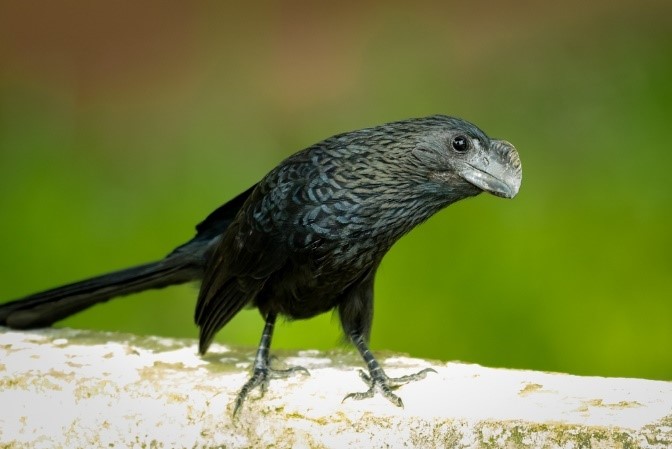Birdfinding.info ⇒ Among the commonest species across most of its large range. Along rural roadsides in the West Indies and South America it is usually harder to avoid it than to find it. Since its historic decline in Florida in the 1980s and ’90s, some of the more consistent sites have been Loxahatchee National Wildlife Refuge, Key Biscayne, and various weedy lots in South Miami.
Smooth-billed Ani
Crotophaga ani
Widespread across South America and the Caribbean. Thrives in a wide array of semiopen habitats—brushland, grassy margins, second growth, mixed agricultural land, etc.—so it generally benefits from deforestation and rural development.
Its range encompasses nearly all of tropical South America south on the Pacific slope to the northernmost tip of Peru’s coastal and east of the Andes to Uruguay. Introduced populations are established on the Galápagos Islands.
Extends into Central America through most of Panama and about halfway up the Pacific lowlands of Costa Rica.
Resident nearly throughout the Caribbean islands, including the Corn Islands of Nicaragua, the Bay Islands of Honduras, and Cozumel, but an irregular visitor to the Belizean cayes and other islands along Yucatán coast.
Sporadic in southeastern Florida, mainly from Palm Beach to Homestead. First established after a series of hurricanes in the 1930s, the Florida population increased until around 1980, then suddenly declined and mostly disappeared by the early 2000s. Since then, it has again increased likely due to occasional immigration from the Bahamas.
Movements. Dispersive in its Caribbean range. Small numbers frequently wander to the Yucatán mainland and peninsular Florida, occasionally farther along the Gulf and Atlantic coasts to Louisiana and Georgia, and exceptionally north to Ohio.
Identification
All-black with a long tail and a deep, laterally compressed bill that has an arched profile—usually with a strong bump at the base. The only similar species in the Americas are the Groove-billed and Greater Anis (see below).
Typically moves in small flocks through brush, fields, and grassy edges, making short, floppy flights and awkward crash landings. Its tail often seems to swing on a loose hinge as it balances on a perch.
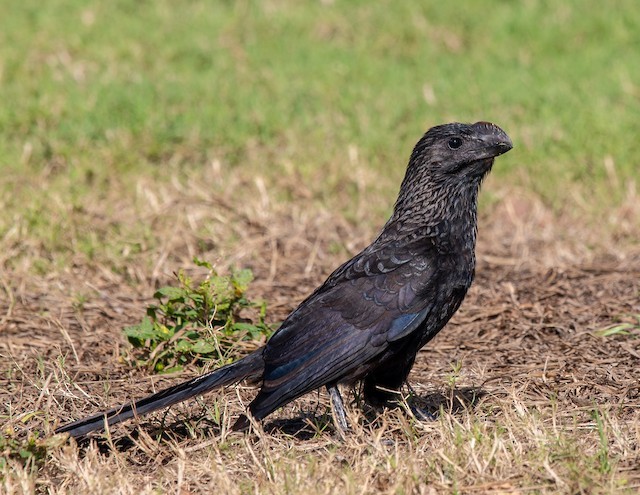
Smooth-billed Ani. (Safehaven, Grand Cayman; February 12, 2019.) © Nic Allen
Bill shape and surface texture are somewhat variable. Although the sides of the bill are generally “smooth,” as its name suggests, they usually have at least one noticeable ridge and may have multiple contours, scrapes, rough patches, and other irregularities. The bills of young birds often lack the distinctive high-arched profile.
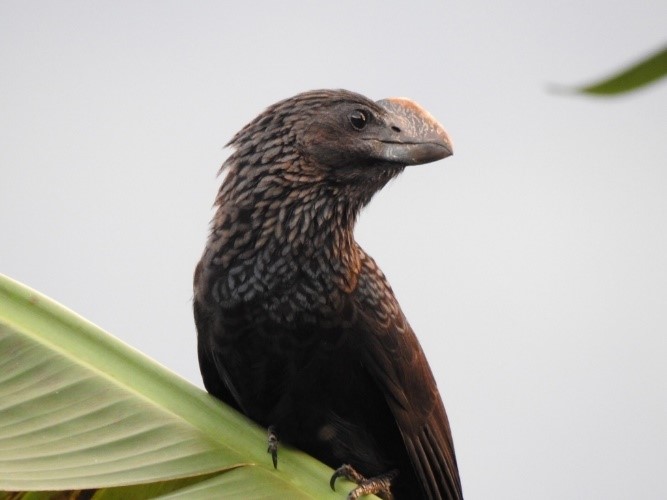
Smooth-billed Ani, showing the high-arched profile of its bill. (Yanzatza, Ecuador; February 16, 2019.) © yago1
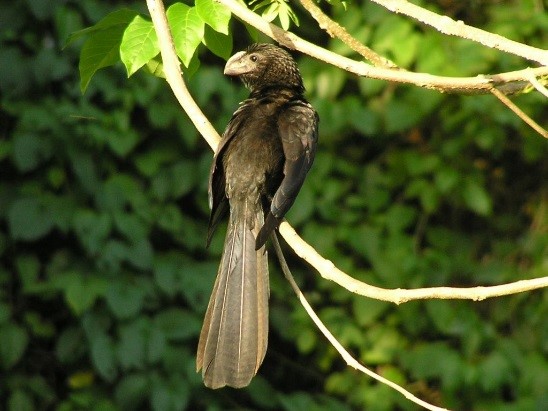
Smooth-billed Ani, showing typical coal-black coloration and long, broad tail. (Mona, Jamaica; August 11, 2006.) © Jan van den Broeck
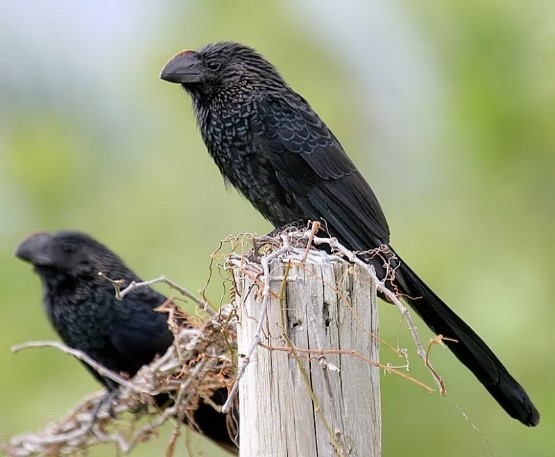
Smooth-billed Ani—note the ridge on the side of the bill. (East End, Grand Cayman; December 14, 2007.) © Steve Metz

Smooth-billed Ani, showing a clearly defined ridge on the side of the bill. (Mastic Trail, Grand Cayman; May 21, 2017.) © Dany Garcia

Smooth-billed Ani, showing a violet sheen on its back. (Leticia, Amazonas, Colombia; March 10, 2019.) © John Guerin
Its plumage typically appears coal-black with a shaggy appearance and grayish highlights on the edges of its feathers. In some cases, however, the plumage has a bluish or violet sheen.
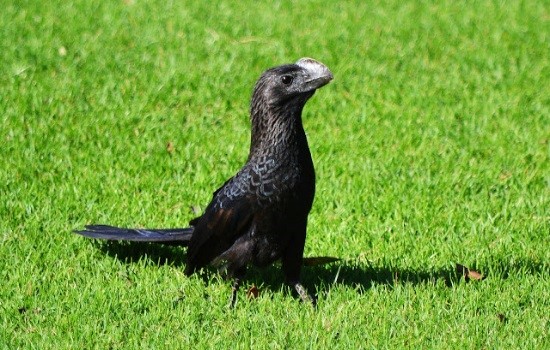
Smooth-billed Ani, showing the high-arched profile of its bill. (La Romana, Dominican Republic; February 2013.) © Luis Sitges
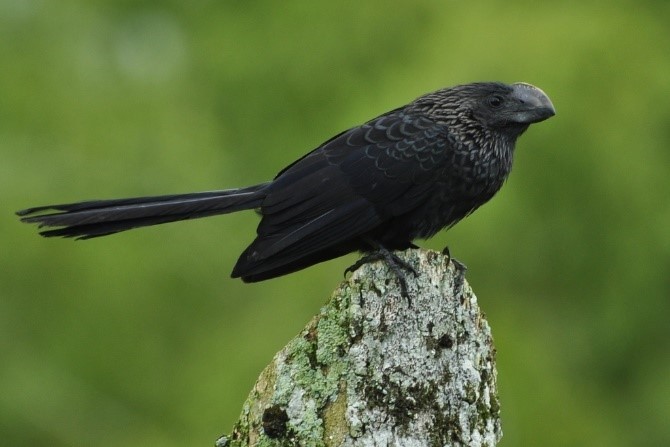
Smooth-billed Ani. (Quimbaya, Quindío, Colombia; December 12, 2011.) © Oscar H. Marín

Smooth-billed Ani. (East End, Grand Cayman; December 14, 2007.) © Steve Metz

Smooth-billed Ani—note the irregular, damaged appearance of the bill. (Piarco, Trinidad; June 26, 2018.) © Chris Rohrer
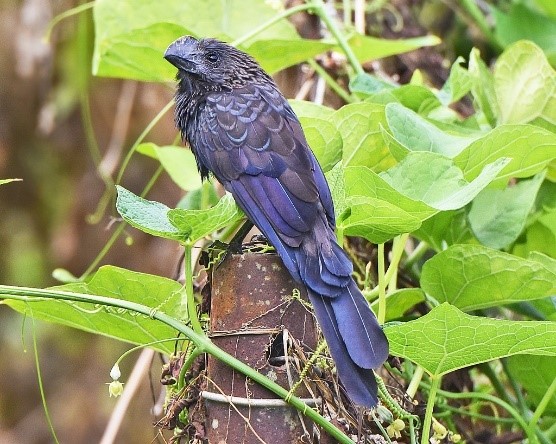
Smooth-billed Ani, showing a bluish sheen on its plumage. (Tunapuna, Trinidad; April 18, 2016.) © Dave Wendelken

Smooth-billed Ani. (North Abaco, Bahamas; January 7, 2013.) © Christoph Moning

Smooth-billed Ani, showing a scraped texture on its bill. (Piarco, Trinidad; June 26, 2018.) © Chris Rohrer
Cf. Groove-billed Ani. Groove-billed and Smooth-billed Anis overlap widely from Costa Rica to Peru, Venezuela, the ABC Islands, and to a limited extent in Florida and the Yucatán region. They are extremely similar and sometimes form mixed flocks.
Field identification of these two species is not always straightforward, and not always resolved even by a good look at the bill—as the bills of both species have an arched profile and usually have some contours on the sides. While some vocalizations are diagnostic, others are confusingly similar.
Bill: An ani whose culmen shows two or three grooves and ridges that parallel the profile of the bill is Groove-billed. An ani whose bill has a steep arch near the base and lacks distinct parallel grooves is Smooth-billed. An ani whose bill has some contours or irregularities and a slight arch near the base could be either species.
Voice: Smooth-billed Ani’s characteristic call ends with a sharp, percussive accent. Groove-billed’s is essentially the opposite in that it begins with a percussive, accented cluck. Ani calls that do not fit either model are not as readily diagnostic.
Cf. Greater Ani. Greater Ani is somewhat similar to Smooth-billed and Groove-billed Anis, but significantly larger and has glossier bluish or purplish plumage, pale eyes, and a differently shaped bill.
Notes
Monotypic species.
References
Alderfer, J., and J.L. Dunn. 2014. National Geographic Complete Birds of North America (Second Edition). National Geographic Society, Washington, D.C.
BirdLife International. 2018. Crotophaga ani. The IUCN Red List of Threatened Species 2018: e.T22684434A131913691. http://dx.doi.org/10.2305/IUCN.UK.2018-2.RLTS.T22684434A131913691.en. (Accessed September 23, 2019.)
eBird. 2019. eBird: An online database of bird distribution and abundance. Cornell Lab of Ornithology, Ithaca, N.Y. http://www.ebird.org. (Accessed September 23, 2019.)
Erritzøe, J., C.F. Mann, F.P. Brammer, and R.A. Fuller. 2012. Cuckoos of the World. Christopher Helm, London.
Fagan, J., and O. Komar. 2016. Peterson Field Guide to the Birds of Northern Central America. Houghton Mifflin Harcourt, New York.
Garrido, O.H, and A. Kirkconnell. 2000. Field Guide to the Birds of Cuba. Cornell University Press, Ithaca, N.Y.
Garrigues, R., and R. Dean. 2014. The Birds of Costa Rica: A Field Guide (Second Edition). Cornell University Press, Ithaca, N.Y.
Payne, R., and G.M. Kirwan. 2019. Smooth-billed Ani (Crotophaga ani). In Handbook of the Birds of the World Alive (J. del Hoyo, A. Elliott, J. Sargatal, D.A. Christie, and E. de Juana, eds.). Lynx Edicions, Barcelona. https://www.hbw.com/node/54907. (Accessed September 23, 2019.)
Raffaele, H., J. Wiley, O. Garrido, A. Keith, and J. Raffaele. 1998. A Guide to the Birds of the West Indies. Princeton University Press, Princeton, N.J.
Ridgely, R.S., and P.J. Greenfield. 2001. The Birds of Ecuador, Volume II: Field Guide. Cornell University Press, Ithaca, N.Y.
Ridgely, R.S., and J.A. Gwynne. 1989. A Guide to the Birds of Panama (Second Edition). Princeton University Press, Princeton, N.J.
Schulenberg, T.S., D.F. Stotz, D.F. Lane, J.P. O’Neill, and T.A. Parker. 2007. Birds of Peru. Princeton University Press, Princeton, N.J.
van Perlo, B. 2009. A Field Guide to the Birds of Brazil. Oxford University Press, Oxford.
Wells, J.V., and A.C. Wells. 2017. Birds of Aruba, Bonaire, and Curaçao. Cornell University Press, Ithaca, N.Y.
